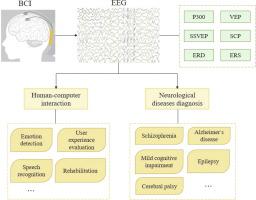当前位置:
X-MOL 学术
›
Neurocomputing
›
论文详情
Our official English website, www.x-mol.net, welcomes your feedback! (Note: you will need to create a separate account there.)
A Review on Transfer Learning in EEG Signal Analysis
Neurocomputing ( IF 6 ) Pub Date : 2021-01-01 , DOI: 10.1016/j.neucom.2020.09.017 Zitong Wan , Rui Yang , Mengjie Huang , Nianyin Zeng , Xiaohui Liu
Neurocomputing ( IF 6 ) Pub Date : 2021-01-01 , DOI: 10.1016/j.neucom.2020.09.017 Zitong Wan , Rui Yang , Mengjie Huang , Nianyin Zeng , Xiaohui Liu

|
Abstract Electroencephalogram (EEG) signal analysis, which is widely used for human-computer interaction and neurological disease diagnosis, requires a large amount of labeled data for training. However, the collection of substantial EEG data could be difficult owing to its randomness and non-stationary. Moreover, there is notable individual difference in EEG data, which affects the reusability and generalization of models. For mitigating the adverse effects from the above factors, transfer learning is applied in this field to transfer the knowledge learnt in one domain into a different but related domain. Transfer learning adjusts models with small-scale data of the task, and also maintains the learning ability with individual difference. This paper describes four main methods of transfer learning and explores their practical applications in EEG signal analysis in recent years. Finally, we discuss challenges and opportunities of transfer learning and suggest areas for further study.
中文翻译:

脑电信号分析中的迁移学习综述
摘要 脑电图(EEG)信号分析广泛用于人机交互和神经系统疾病诊断,需要大量标记数据进行训练。然而,由于其随机性和非平稳性,大量 EEG 数据的收集可能很困难。此外,脑电数据存在显着的个体差异,影响模型的可重用性和泛化性。为了减轻上述因素的不利影响,该领域应用了迁移学习,将在一个领域中学到的知识迁移到另一个不同但相关的领域。迁移学习用任务的小规模数据调整模型,也保持了个体差异的学习能力。本文描述了迁移学习的四种主要方法,并探讨了它们近年来在 EEG 信号分析中的实际应用。最后,我们讨论了迁移学习的挑战和机遇,并提出了进一步研究的领域。
更新日期:2021-01-01
中文翻译:

脑电信号分析中的迁移学习综述
摘要 脑电图(EEG)信号分析广泛用于人机交互和神经系统疾病诊断,需要大量标记数据进行训练。然而,由于其随机性和非平稳性,大量 EEG 数据的收集可能很困难。此外,脑电数据存在显着的个体差异,影响模型的可重用性和泛化性。为了减轻上述因素的不利影响,该领域应用了迁移学习,将在一个领域中学到的知识迁移到另一个不同但相关的领域。迁移学习用任务的小规模数据调整模型,也保持了个体差异的学习能力。本文描述了迁移学习的四种主要方法,并探讨了它们近年来在 EEG 信号分析中的实际应用。最后,我们讨论了迁移学习的挑战和机遇,并提出了进一步研究的领域。


























 京公网安备 11010802027423号
京公网安备 11010802027423号